Letters from Lodi
An insightful and objective look at viticulture and winemaking from the Lodi
Appellation and the growers and vintners behind these crafts. Told from the
perspective of multi-award winning wine journalist, Randy Caparoso.
Appreciating California Zinfandels for what they are and where they're grown, not for what you're told they're supposed to be
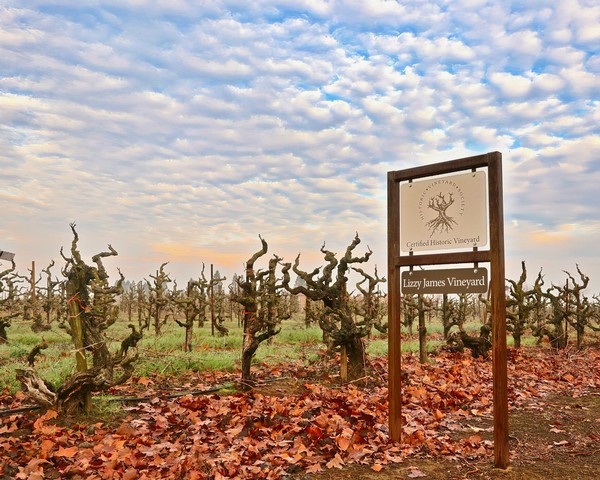
Winter scene: Lizzy James Vineyard, a certified Historic Vineyard Society block on the east side of Lodi's Mokelumne River AVA.
To truly grasp Lodi grown Zinfandels—or Zinfandels from anywhere else, for that matter—it helps to understand how they compare with Zinfandels from other California wine regions.
The problem is, you cannot trust everything you read or are told about Zinfandels. While generally well meaning, many journalists simply repeat what they themselves are told about the varietal category, rather than thinking for themselves, so they end up repeating erroneous information and ideas.
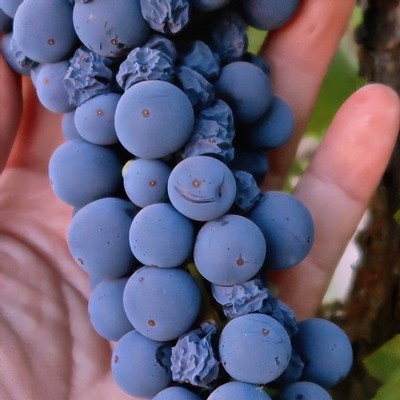
"Happy" Zinfandel cluster demonstrating the uneven ripeness in individual berries very typical of the grape.
A few years ago, for instance, one wine blogger offered up "tips" on what to expect about California Zinfandels in general, writing...
When choosing a Zinfandel, pay particular attention to the alcohol level listed on the label. The higher the alcohol, the higher the odds that the wine will be sweet, jammy and powerfully rich.
Zinfandel grows all over California, and the style of the wine varies according to the wine region and specific location of the vineyard, as well as the age of the vines for any particular wine. In general, the following holds true:
• The cooler areas, which include many of the coastal counties, tend to produce spicier, leaner, and more refined wines.
• The interior regions tend to make richer, lustier, more powerful Zinfandel wines.
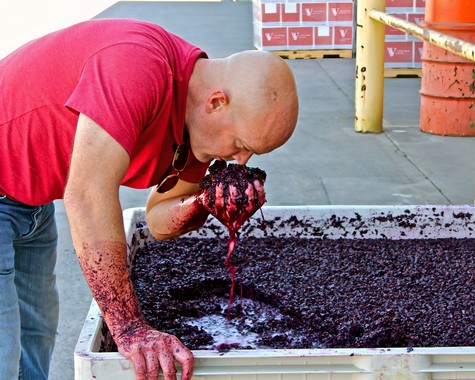
McCay Cellars' Mike McCay examining a fermenting Lodi Zinfandel.
Two things wrong with this advice. First, ask any winemaker, and they'll tell you that the alcohol levels divulged on wine labels—called ABV, or "Alcohol by Volume"—are approximations at best. It's what they put on the bottle just to get a label through the approval process with the TTB (the federal government's Alcohol and Tobacco Tax and Trade Bureau)—usually long before their wines are bottled, when they know their wines' actual alcohol level.
In other words, the percent of alcohol you see on a label does not always correspond with the exact alcohol content in a bottle. In fact, the TTB allows wineries 1.5% leeway for wines finished between 7% and 14% alcohol. Therefore, a bottle that reads 12.5% alcohol may actually be 14% alcohol, or vice versa. Wines finished over 14% alcohol, which are in a different tax bracket, are given a 1% leeway by the TTB; which means that a bottle that reads 15% alcohol may actually be as high as 16%, or as low as 14%.
Therefore, the worse thing a consumer can do is choose a wine based upon the ABV stated on a label, which is rarely precise, and doesn’t give you a true picture of what you’ll actually find in the bottle. Don't get me wrong—many wineries are conscientiously truthful. Problem is, many wineries are not, so let the buyer beware. Don't believe what you see on a bottle!
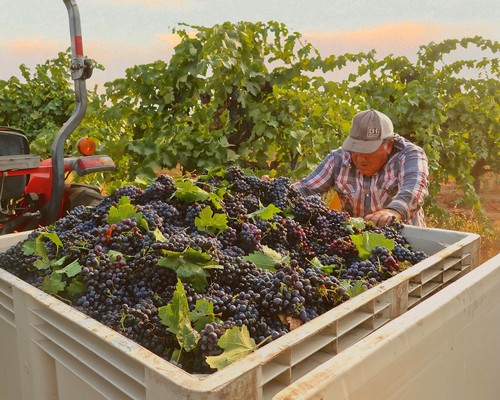
Lodi Zinfandel harvest in Turley Wine Cellars' Steacy Ranch.
Neither should you be fooled by fractions. One winemaker once candidly told me, "I'll put 14.1% or 14.2% on a label, even when I know a wine will be more than 15% alcohol, because I don't want to give people the impression that we're going for a high alcohol style Zinfandel." Some wineries will put down a 14.9% ABV because they want to give consumers the impression that their wine is "big and bold," yet maybe not too big. Yes, it's all about marketing; or in another sense, a little white lie told to push an idea. But the TTB allows this for what it believes to be a practical reason—to make it easier and more cost-effective for wineries to expedite their label approvals and get their products out the door—and therefore wine producers will continue to exercise that freedom to suit their purposes.
The second issue: Although the aforementioned "tips author" implies that "interior" regions —meaning, areas such as Lodi, Contra Costa or the Sierra Foothills—make "richer, lustier, more powerful" wines than "cooler areas" (by implication, regions such as Napa and Sonoma) where "leaner, more refined" Zinfandels are supposedly made, these assumptions rarely hold true when it comes to contemporary handcraft styles of the varietal. Especially bottlings with specific vineyard designations, which are more likely to compel brands to produce a Zinfandel expressing sensory qualities typifying a vineyard or region, as opposed to bottlings meant to express varietal character (i.e., the commercially expected taste of a grape, regardless of vineyard source).
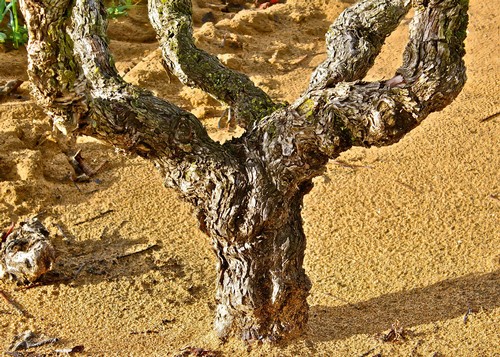
Gobelet (i.e., "head") trained vine over 100 years old growing in the ultra-sandy soil of Contra Costa, producing floral styles of Zinfandel.
In fact, Zinfandel specialists who work with multiple regions of California actually say the opposite of what is commonly assumed is true: The leaner, more delicate Zinfandels tend to come from regions such as Contra Costa, the Foothills and Lodi, while the lustier, more powerful, higher alcohol Zinfandels come from Napa or Sonoma. If anything, that is the reason why Sonoma and Napa Zinfandels are so popular in the first place.
Ehren Jordan, the former winemaker of the prestigious Zinfandel brand Turley Wine Cellars, has put it this way: "Anybody who says Lodi is a hot Central Valley growing region producing big, ripe wines doesn't know his stuff. In all my years, I can't think of a single year when our Lodi fruit wasn't picked after our vineyards in, say, mid-Napa Valley, which is always a warmer growing region than Lodi."

Amador County vines in winter, producing nuanced, savory, structured (as opposed to "big" or "opulent") styles of Zinfandel.
To some extent, this also goes for Zinfandels from Amador County and the rest of the Sierra Foothills AVA. Tegan Passalacqua, the current Turley winemaker, likes to talk about the "fine grained granitic tannin" as well as "rose petal and zest of orange peel" nuances he finds unique to Zinfandels grown in the Foothills. Says Passalacqua, "It's a great example of how erroneous the assumption is—that anything east of Napa is 'warm climate,' therefore bigger or less delicate in structure."
Which is not to say that lusty, ripe, high alcohol Zinfandels aren't produced in Lodi or the Foothills. Many of the larger volume, commercial wineries, for instance, deliberately pick Lodi grown Zinfandel ultra-high in sugar to achieve "jammy" fruit qualities, and simply add water to fermentation vats to reduce alcohol levels to below 15%. They'll also blend in Petite Sirah (up to 24.9%, which is the legally allowed proportion for a varietal wine) to bolster color and body, and employ lots of oak flavor in order to approximate a hefty "Sonoma" or "Napa" style, which they assume many consumers expect in wines sold as "Zinfandel."
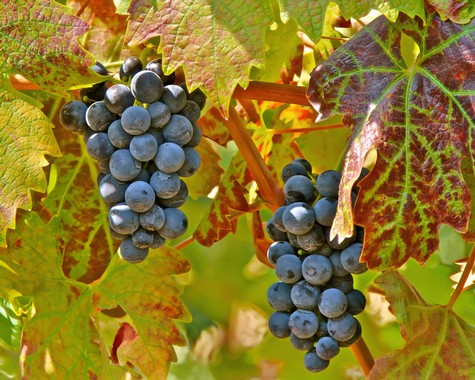
Tiny clustered clusters typical of Zinfandel growing in high elevation vineyards in the El Dorado AVA.
The point, though, is that "big" qualities are typical of Zinfandel picked at higher sugars and loaded with oak qualities in virtually all of California’s wine regions, Napa, Sonoma, Lodi and the Sierra Foothills alike. It's just that, generally speaking, winegrowers who actually farm these regions will tell you that when Zinfandels are produced in more natural, lower intervention styles, the leaner, purer, more restrained Zinfandels are more likely to come from regions located east of Napa, rather than west of it.
There is, however, a sad part about this. Which is that many, many premium priced (by today's standards, over $40) Zinfandels, particularly bottlings sourced from North Coast vineyards, are still made in commercial styles contrived to capture the darkest colored, heaviest, oakiest, high tannin and extracted qualities possible in order to take advantage of the public perception that the "best" wines possess such over-the-top attributes. When in fact, pure Zinfandels made to be faithful to their vineyards or places of origin anywhere in the state are actually the opposite: Lighter colored, more elevated in acidity than in tannin, and delicate and finely delineated—almost like Pinot Noir (although certainly not the same as Pinot Noir, since that's a completely different varietal).

Pure old vine Zinfandel (from Lodi vines planted over 100 years ago): Reddish, floral, delicate, zesty in acidity—not black colored, hefty and higher in tannin and oak than the varietal's natural, zesty acidity.
But that's the persistent state of California wine, still dominated by the bigger-the-better mentality that rose up, some time during the 1980s, when score-driven "ratings" first reared its ugly head, compelling consumers and vintners alike to kowtow to that convention. Someday it will change. I have a lot of faith in the wisdom of both consumers and the industry, and that common sense will eventually prevail.
What sommeliers have said
Say what you will about sommeliers—restaurant wine professionals trained to evaluate wine with precision (whether or not they still work in restaurants). Although many of them are influenced as much as anyone by what they read or what they are told, sommeliers tend to describe wines the way they taste them. Especially California based sommeliers, who have the luxury of tasting Zinfandels in their own backyards (sommeliers working outside the state and who have never visited California are probably more susceptible to misinformation).
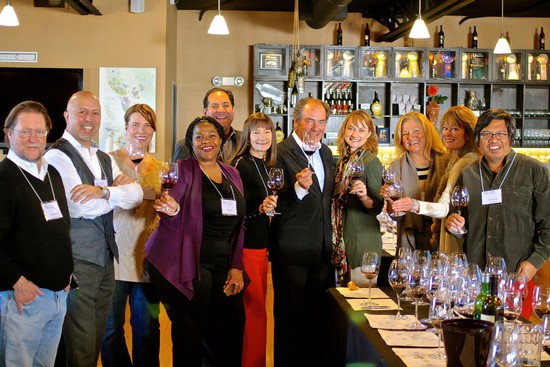
Sommeliers tasting Zinfandels with the famous wine glass maker Georg Riedel (middle) at a past ZAP "Experience" in San Francisco.
Back in 2014 I was enlisted by ZAP (Zinfandel Advocates and Producers) to organize a sommelier led seminar at their annual January "Experience" (now called ZinEX) in San Francisco. I was asked to focus on a "TERROIR" theme—that is, to present Zinfandels from the perspective of what the French would call terroir, or a "sense of place," derived from a vineyard or region where a wine is grown. To do that, I assigned several prominent California sommeliers to individual regions known for Zinfandel, asking each of them to give a presentation on the sensory qualities they have found.
The first sommelier to present at the seminar was Christopher Sawyer—at the time, the wine director of a high end Napa Valley restaurant—who presented Sonoma County Zinfandels bottled as single vineyards. Sawyer described one of the Sonoma Zinfandel as "rich, plush, quintessential," and the other one as "ripe, robust, opulent"—all typical descriptors for Sonoma grown iterations of the grape.
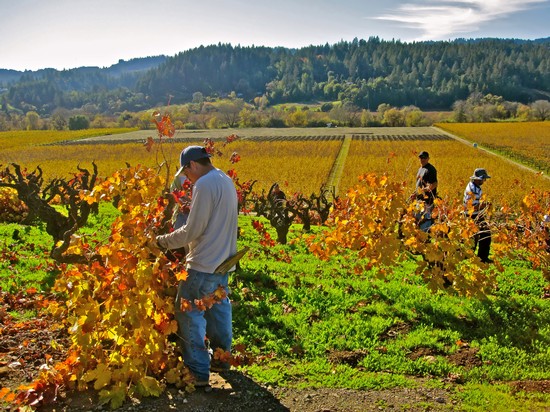
Early winter pruning of head trained Zinfandel in Sonoma County's Dry Creek Valley.
Robert Bath MS, an educator at CIA at Greystone, was tasked with presenting Zinfandels from Sonoma’s Dry Creek Valley—in many ways, another quintessential source of Sonoma County (thus, for all of California) Zinfandel. Sure enough, Bath described a Dry Creek Valley Zinfandel crafted by Ridge Vineyards—a producer famous for its varietal bottlings since the 1960s—as an “essence of the grape... briary, brambly, jamming in both red and black berryish fruit.”
It was after the Sonoma County Zinfandels, however, where the seminar got interesting: Attendees got to make a direct comparison of Sonoma County Zinfandels with those of other regions. The contrast was fascinating. First up was a Master Sommelier named Catherine Fallis of planetgrape.com. Fallis presented two Lodi Zinfandels, Harney Lane's Lizzy James and McCay's Trulux Vineyard bottlings, which she described with unerring detail: "These Zinfandel styles are not punchy… they rely on more of a subtle, balanced, grounded intensity, very much a reflection of Lodi's steady, dependable Mediterranean climate… not big like the Sonoma Zinfandels, yet complex and characterful in their own way."
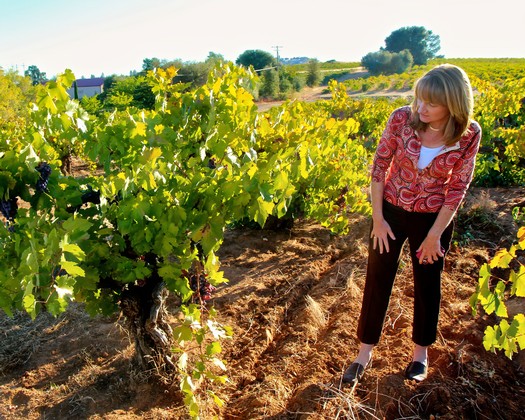
Taste Restaurant co-owner/director of operations Tracey Berkner with ancient vines (well over 100 years old) in Amador County.
Next up was Tracey Berkner, the co-owner of Taste Restaurant & Wine Bar in Plymouth, who talked about the mountain grown Zinfandels of the Sierra Nevada's El Dorado AVA⏤over 2,000 feet higher in elevation than most vineyards in Sonoma County or Lodi. While leading a tasting of El Dorado Zinfandels grown by Cedarvillle and Lava Cap, Berkner talked about "distinguishing nuances of pepper, herbal and earthy notes… especially minerally and woodsy qualities going beyond Zinfandel fruitiness." And in fact, these Zinfandels were so different from the Sonoma County Zinfandels on several sensory levels, they might as well have been made from a different grape!
Why, then, are Sonoma County Zinfandels considered "quintessential" California Zinfandels? Beats me. Wine lovers around the world all say the same thing: There is nothing like a wine that captures its sense of place in a vivid yet equally delicious fashion, which renders the entire idea of one region's wines being "better" than another's as complete and utter nonsense.
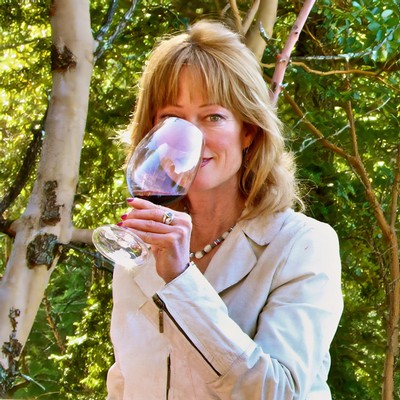
Master Sommelier Catherine Fallis, one of the wine industry's biggest supporters of Lodi grown wines.
The next presenter was Rob Renteria, a longtime San Francisco sommelier, who invited Bill Easton, the owner/winemaker of Terre Rouge and Easton, to help draw a picture of Amador County where you find plantings at elevations from 500 to 2,300 feet, plus 30° to 35° growing season temperature swings that allow grapes to retain elevated acidity—resulting in probably the zestiest Zinfandels in California (although those of the high elevation Mendocino Ridge AVA might give Amador County a run for the money). Typifying these grape growing extremes, the Easton Rinaldi Zinfandel, produced from 100 to 120-year old vines, came across as lean and sinewy, with a touch of rustique—rich in varietal berryishness, but in not nearly an obvious way as Zinfandels from Sonoma or Napa. A savory, rather than tutti-fruity, expression of the grape.
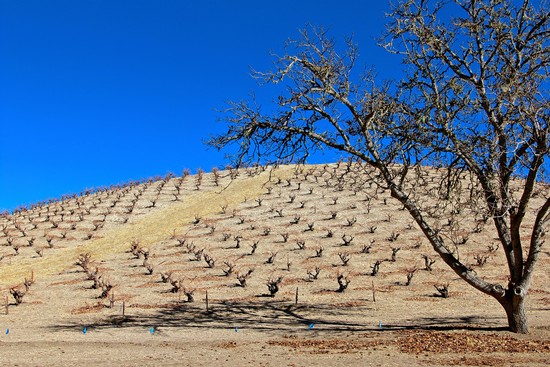
140-year old vines in Ueberroth Vineyard, growing in the chalky hillside soils of Paso Robles producing Zinfandels of such distinctive minerality and fragrances (totally unlike Sonoma County or Napa Valley), they might as well be made from a different grape!
Finally, I took my own turn, presenting two Zinfandels from Paso Robles, a region half-way between San Francisco and Los Angeles with completely different terroirs compared to anywhere else in California: Most notably, chalky, limestone-replete hillside soils and even wider diurnal temperature swings (as much as 40º or even 50°) during sun soaked summers. The results are Zinfandel that are, in fact, extremely minerally, notably zesty in acidity, yet brightly perfumed with floral notes (almost as much as Lodi grown Zinfandels). As far as the varietal category goes, a completely different animal—to say the least.
Sommeliers may work in fancy restaurants, and winemakers in dusty fields and grungy cellars. Yet both sommeliers and winemakers agree: Zinfandels grown and produced to reflect individual terroirs are meant to reflect the diversity, not sameness, of varietal character—more than enough to suit most everyone's varying tastes and culinary needs. And thank goodness. It would be an awfully boring world if all wines were grown or made to taste alike.

Gobelet trained Zinfandel over 100 years old in Sonoma County's Russian River Valley.
Sameness may work for grocery store shelves, but not for connoissseurs of the grape looking for differentiation, or for what is often called "transparency"—distinguishable sensory qualities reflecting where a wine is grown.
Whether you prefer the leaner, more restrained, often earthy styles grown in Lodi or the Foothills, or the classic, old, big alcohol, ultra-ripe styles of Napa or Sonoma, the important thing is appreciating these Zinfandels for what they are, not for what some people are telling you they're supposed to be.
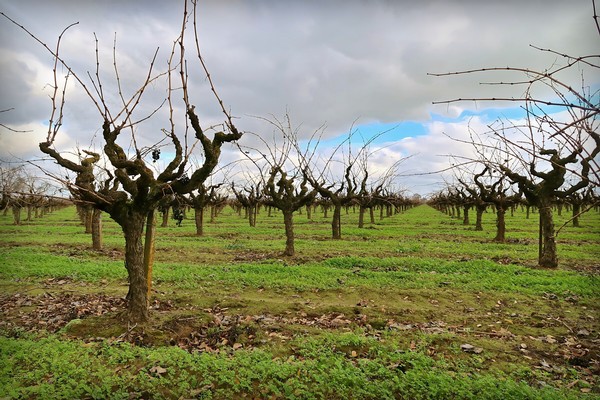
Classic gobelet trained Zinfandel during winter on the east side of Lodi's Mokelumne River appellation.